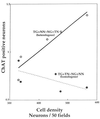Cerebral cortical astroglia from the trisomy 16 mouse, a model for down syndrome, produce neuronal cholinergic deficits in cell culture
- PMID: 9356503
- PMCID: PMC25068
- DOI: 10.1073/pnas.94.23.12644
Cerebral cortical astroglia from the trisomy 16 mouse, a model for down syndrome, produce neuronal cholinergic deficits in cell culture
Abstract
Trisomy 21 (Down syndrome) is associated with a high incidence of Alzheimer disease and with deficits in cholinergic function in humans. We used the trisomy 16 (Ts16) mouse model for Down syndrome to identify the cellular basis for the cholinergic dysfunction. Cholinergic neurons and cerebral cortical astroglia, obtained separately from Ts16 mouse fetuses and their euploid littermates, were cultured in various combinations. Choline acetyltransferase activity and cholinergic neuron number were both depressed in cultures in which both neurons and glia were derived from Ts16 fetuses. Cholinergic function of normal neurons was significantly down-regulated by coculture with Ts16 glia. Conversely, neurons from Ts16 animals could express normal cholinergic function when grown with normal glia. These observations indicate that astroglia may contribute strongly to the abnormal cholinergic function in the mouse Ts16 model for Down syndrome. The Ts16 glia could lack a cholinergic supporting factor present in normal glia or contain a factor that down-regulates cholinergic function.
Figures



Similar articles
-
Regional alteration of cholinergic function in central neurons of trisomy 16 mouse fetuses, an animal model of human trisomy 21 (Down syndrome).Brain Res. 1994 Sep 26;658(1-2):27-32. doi: 10.1016/s0006-8993(09)90006-3. Brain Res. 1994. PMID: 7834352
-
Nerve growth factor corrects developmental impairments of basal forebrain cholinergic neurons in the trisomy 16 mouse.Proc Natl Acad Sci U S A. 1991 Mar 1;88(5):1793-7. doi: 10.1073/pnas.88.5.1793. Proc Natl Acad Sci U S A. 1991. PMID: 2000385 Free PMC article.
-
Knockdown of Myo-Inositol Transporter SMIT1 Normalizes Cholinergic and Glutamatergic Function in an Immortalized Cell Line Established from the Cerebral Cortex of a Trisomy 16 Fetal Mouse, an Animal Model of Human Trisomy 21 (Down Syndrome).Neurotox Res. 2017 Nov;32(4):614-623. doi: 10.1007/s12640-017-9775-0. Epub 2017 Jul 10. Neurotox Res. 2017. PMID: 28695546
-
The cholinergic system in Down's syndrome.J Intellect Disabil. 2006 Sep;10(3):261-74. doi: 10.1177/1744629506067615. J Intellect Disabil. 2006. PMID: 16916850 Review.
-
Cholinergic markers in the cortex and hippocampus of some animal species and their correlation to Alzheimer's disease.Neurologia. 2014 Oct;29(8):497-503. doi: 10.1016/j.nrl.2012.10.007. Epub 2013 Feb 22. Neurologia. 2014. PMID: 23433740 Review. English, Spanish.
Cited by
-
A human isogenic iPSC-derived cell line panel identifies major regulators of aberrant astrocyte proliferation in Down syndrome.Commun Biol. 2021 Jun 14;4(1):730. doi: 10.1038/s42003-021-02242-7. Commun Biol. 2021. PMID: 34127780 Free PMC article.
-
Neonatal mice of the Down syndrome model, Ts65Dn, exhibit upregulated VIP measures and reduced responsiveness of cortical astrocytes to VIP stimulation.J Mol Neurosci. 2006;30(3):329-40. doi: 10.1385/JMN:30:3:329. J Mol Neurosci. 2006. PMID: 17401158
-
A role for thrombospondin-1 deficits in astrocyte-mediated spine and synaptic pathology in Down's syndrome.PLoS One. 2010 Dec 2;5(12):e14200. doi: 10.1371/journal.pone.0014200. PLoS One. 2010. PMID: 21152035 Free PMC article.
-
The place of choline acetyltransferase activity measurement in the "cholinergic hypothesis" of neurodegenerative diseases.Neurochem Res. 2008 Feb;33(2):318-27. doi: 10.1007/s11064-007-9497-4. Epub 2007 Oct 17. Neurochem Res. 2008. PMID: 17940885 Review.
-
Astroglial and microglial pathology in Down syndrome: Focus on Alzheimer's disease.Front Cell Neurosci. 2022 Sep 20;16:987212. doi: 10.3389/fncel.2022.987212. eCollection 2022. Front Cell Neurosci. 2022. PMID: 36212691 Free PMC article. Review.
References
-
- Muller H W, Junhans U, Kappler J. Pharmacol Ther. 1995;65:1–18. - PubMed
-
- Oster-Granite M L, Lacey-Casem M L. Ment Retard Dev Disabil Rev. 1995;1:227–236.
-
- Hayes A, Batshaw M L. Pediatr Clin North Am. 1993;40:523–535. - PubMed
-
- Smith D J, Stevens M E, Sudanagunta S P, Bronson R T, Makhinson M, Watabe A M, O’Dell T J, Fung J, Weier H-U, Cheng J-F, Rubin E M. Nat Genet. 1997;16:28–36. - PubMed
-
- Coyle J T, Oster-Granite M L, Reeves R H, Gearhart J D. Trends Neurosci. 1988;11:390–394. - PubMed
MeSH terms
Substances
LinkOut - more resources
Full Text Sources
Medical

